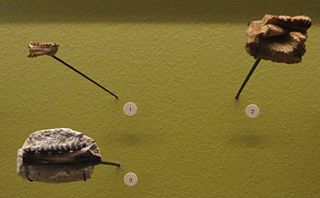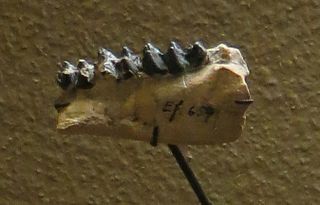
The family Aplodontiidae also known as Aplodontidae, Haplodontiidae or Haploodontini is traditionally classified as the sole extant family of the suborder Protrogomorpha. It may be the sister family of the Sciuridae. There are fossils from the Oligocene until Miocene in Asia, from Oligocene in Europe and from the Oligocene until the present in North America, where there is the only living species: the mountain beaver.

Diatomyidae is a family of hystricomorph rodents. It is represented by a single living species, Laonastes aenigmamus, native to Laos in Southeast Asia. Fossil species are known from the Oligocene and Miocene of Asia and eastern Europe.
Corbarimys cezannei, formerly Pseudoparamys cezannei, is a species of extinct rodent in family Ischyromyidae. It is named after French Post-Impressionist painter Paul Cézanne.
Duerotherium is an extinct genus of Palaeogene artiodactyls known only from the Iberian Peninsula during the Middle Eocene, which contains one species D. sudrei. It, like other members of the Anoplotheriidae, was endemic to Western Europe. The anoplotheriine was described from a left fragment of a maxilla from the Mazaterón Formation of the Duero Basin in 2009. Its dentition is mostly typical of the Anoplotheriinae but differs by an elongated plus triangular 3rd upper premolar and very specific traits of the molars. It is thought to have been part of an endemic faunal assemblage that evolved within the Iberian Peninsula by the Middle Eocene, where climates were subtropical.

Xiphodon is the type genus of the extinct Palaeogene artiodactyl family Xiphodontidae. It, like other xiphodonts, was endemic to Western Europe and lived from the middle Eocene up to the earliest Oligocene. Fossils from Montmartre in Paris, France that belonged to X. gracilis were first described by the French naturalist Georges Cuvier in 1804. Although he assigned the species to Anoplotherium, he recognized that it differed from A. commune by its dentition and limb bones, later moving it to its own subgenus in 1822. Xiphodon was promoted to genus rank by other naturalists in later decades. It is today defined by the type species X. gracilis and two other species, X. castrensis and X. intermedium.
This paleomammalogy list records new fossil mammal taxa that were described during the year 2012, as well as notes other significant paleomammalogy discoveries and events which occurred during that year.
This paleomammalogy list records new fossil mammal taxa that were described during the year 2013, as well as notes other significant paleomammalogy discoveries and events which occurred during that year.

Cainotheriidae is an extinct family of artiodactyls known from the Late Eocene to Middle Miocene of Europe. They are mostly found preserved in karstic deposits.
The Lignites de Soissonais is a geologic formation in the Var, Marne departments of France. It preserves fossils dating back to the Ypresian stage of the Eocene period.
The Quercy Phosphorites Formation is a geologic formation and lagerstätte in Occitanie, southern France. It preserves fossils dated to the Paleogene period, or MP16 to MP28 zones of the European land mammal age classification, ranging from approximately 38 to 25 Ma.

Necromantis is an extinct genus of bat that lived during the Eocene. Its fossils are found in the Quercy Phosphorites Formation of France and the Djebel Chambi in Tunisia. Specimens of Necromantis are notable for their large size and specialization towards a predatory lifestyle.

Dichodon is an extinct genus of Palaeogene artiodactyls belonging to the family Xiphodontidae. It was endemic to Western Europe and lived from the middle Eocene up to the earliest Oligocene. The genus was first erected by the British naturalist Richard Owen in 1848 based on dental remains from the fossil beds in Hordle, England. He noticed similar dentitions to contemporary artiodactyls like those of the Anoplotheriidae and Dichobunidae and references the name of the genus Dichobune. Eventually, it was found to be more closely related to Xiphodon and now includes 11 species, although one of them may be synonymous.

Dacrytherium is an extinct genus of Palaeogene artiodactyls belonging to the family Anoplotheriidae. It occurred from the Middle to Late Eocene of Western Europe and is the type genus of the subfamily Dacrytheriinae, the older of the two anoplotheriid subfamilies. Dacrytherium was first erected in 1876 by the French palaeontologist Henri Filhol, who recognised in his studies that it had dentition similar to the anoplotheriids Anoplotherium and Diplobune but differed from them by a deep preorbital fossa and a lacrimal fossa, the latter of which is where the genus name derives from. D. ovinum, originally classified in Dichobune, is the type species of Dacrytherium. Henri Filhol named D. elegans in 1884, and Hans Georg Stehlin named the species D. priscum and D. saturnini in 1910.

Catodontherium is an extinct genus of Palaeogene artiodactyls belonging to the family Anoplotheriidae. It was endemic to Western Europe and had a temporal range exclusive to the middle Eocene, although its earliest appearance depends on whether C. argentonicum is truly a species of Catodontherium. It was first named Catodus by the French palaeontologist Charles Depéret in 1906, who created two species for the genus and later changed the genus name to Catodontherium in 1908. The Swiss palaeontologist Hans Georg Stehlin renamed one species and classified two other newly erected species to Catodontherium in 1910. Today, there are four known species, although two remain questionable in genus placement.
Ephelcomenus is an extinct genus of Palaeogene artiodactyls endemic to Western Europe. It contains one species E. filholi, which was first described by Richard Lydekker in 1889 but eventually classified to its own genus by the Swiss palaeontologist Johannes Hürzeler in 1938. It has an uncertain stratigraphic range, but some sources suggest that it was present in the Oligocene after the Grande Coupure turnover event of western Europe.
Robiatherium is an extinct genus of Palaeogene artiodactyls containing one species R. cournovense. The genus name derives from the locality of Robiac in France where some of its fossil were described plus the Greek θήρ/therium meaning "beast" or "wild animal". It was known only from the middle Eocene and, like other anoplotheriids, was endemic to Western Europe. The genus was erected by Jean Sudre in 1988 for a species originally attributed to the xiphodont genus Paraxiphodon in 1978. Robiatherium had dentitions typical of the subfamily Anoplotheriinae, differing from other genera by specific differences in the molars. It is one of the earliest-appearing anoplotheriine species in the fossil record as well as the earliest to have appeared in Central Europe.
Haplomeryx is an extinct genus of Palaeogene artiodactyls belonging to the family Xiphodontidae. It was endemic to Western Europe and lived from the middle Eocene up to the earliest Oligocene. Haplomeryx was first established as a genus by the German naturalist Max Schlosser in 1886 based on a molar tooth set from Quercy Phosphorites deposits. Three additional species were erected and classified to the xiphodontid genus while one other species, first recognized in 1822, was tentatively classified to it and remains unresolved in affinity.
Auroremys is an extinct genus of Palaeogene rodents belonging to the theridomorph family Pseudosciuridae. The type and only species Auroremys subita was first named by Bernard Comte et al. in 2012 as belonging to the ischyromyid genus Ailuravus before it was eventually reclassified to its own genus by French palaeontologists Monique Vianey-Liaud and Laurent Marivaux in 2021.
Burgia is an extinct genus of Palaeogene rodents belonging to the family Theridomyidae. It is more specifically classified to the subfamily Patriotheridomyinae and contains one species Burgia marandati. The type and only species was originally classified to another genus name Bernardia by Monique Vianey-Liaud in 1991 before the genus name usage was rendered invalid due to it being preoccupied by a scale insect in 1891. Burgia marandati is known from a holotype consisting of a lower molar from the French locality of Lavergne that dates to the middle Eocene. The genus is named after the Bach mayor Pierre Burg, who assisted palaeontologists in their research locally.
Idicia is an extinct genus of Palaeogene rodents belonging to the family Theridomyidae. The genus and its sole species Idicia vidalenci were both named by Monique Vianey-Liaud et al. in 2024 based on some holotype dentition from the French locality of Lavergne, dating to the middle Eocene. It was named in honor of Dominique Vidalenc, who discovered the holotype material. It is diagnosed as being a medium-sized and brachyodont (low-crowned) theridomyid with various specific morphologies of its cuspids. A wide range of other faunas were recovered form Lavergne along with Idicia such as the herpetotheriid Peratherium, nyctithere Saturninia, omomyid Necrolemur, carnivoraforme Quercygale, tapirulid Tapirulus, and the palaeothere Palaeotherium.







